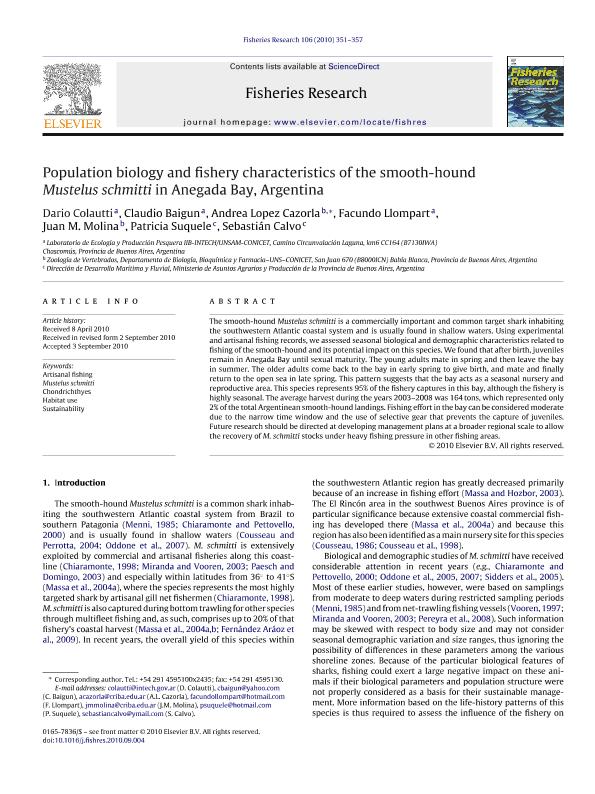Mostrar el registro sencillo del ítem
dc.contributor.author
Colautti, Dario César

dc.contributor.author
Baigún, Claudio Rafael M.

dc.contributor.author
Lopez Cazorla, Andrea Cecilia

dc.contributor.author
Llompart, Facundo Manuel

dc.contributor.author
Molina, Juan Manuel

dc.contributor.author
Suquele, Patricia
dc.contributor.author
Calvo, Sebastián
dc.date.available
2019-06-12T22:01:35Z
dc.date.issued
2010-12
dc.identifier.citation
Colautti, Dario César; Baigún, Claudio Rafael M.; Lopez Cazorla, Andrea Cecilia; Llompart, Facundo Manuel; Molina, Juan Manuel; et al.; Population biology and fishery characteristics of the smooth-hound Mustelus schmitti in Anegada Bay, Argentina; Elsevier Science; Fisheries Research; 106; 3; 12-2010; 351-357
dc.identifier.issn
0165-7836
dc.identifier.uri
http://hdl.handle.net/11336/78158
dc.description.abstract
The smooth-hound Mustelus schmitti is a commercially important and common target shark inhabiting the southwestern Atlantic coastal system and is usually found in shallow waters. Using experimental and artisanal fishing records, we assessed seasonal biological and demographic characteristics related to fishing of the smooth-hound and its potential impact on this species. We found that after birth, juveniles remain in Anegada Bay until sexual maturity. The young adults mate in spring and then leave the bay in summer. The older adults come back to the bay in early spring to give birth, and mate and finally return to the open sea in late spring. This pattern suggests that the bay acts as a seasonal nursery and reproductive area. This species represents 95% of the fishery captures in this bay, although the fishery is highly seasonal. The average harvest during the years 2003-2008 was 164. tons, which represented only 2% of the total Argentinean smooth-hound landings. Fishing effort in the bay can be considered moderate due to the narrow time window and the use of selective gear that prevents the capture of juveniles. Future research should be directed at developing management plans at a broader regional scale to allow the recovery of M. schmitti stocks under heavy fishing pressure in other fishing areas.
dc.format
application/pdf
dc.language.iso
eng
dc.publisher
Elsevier Science

dc.rights
info:eu-repo/semantics/openAccess
dc.rights.uri
https://creativecommons.org/licenses/by-nc-sa/2.5/ar/
dc.subject
Artisanal Fishing
dc.subject
Chondrichthyes
dc.subject
Habitat Use
dc.subject
Mustelus Schmitti
dc.subject
Sustainability
dc.subject.classification
Otras Ciencias Biológicas

dc.subject.classification
Ciencias Biológicas

dc.subject.classification
CIENCIAS NATURALES Y EXACTAS

dc.subject.classification
Meteorología y Ciencias Atmosféricas

dc.subject.classification
Ciencias de la Tierra y relacionadas con el Medio Ambiente

dc.subject.classification
CIENCIAS NATURALES Y EXACTAS

dc.title
Population biology and fishery characteristics of the smooth-hound Mustelus schmitti in Anegada Bay, Argentina
dc.type
info:eu-repo/semantics/article
dc.type
info:ar-repo/semantics/artículo
dc.type
info:eu-repo/semantics/publishedVersion
dc.date.updated
2019-06-10T14:06:16Z
dc.journal.volume
106
dc.journal.number
3
dc.journal.pagination
351-357
dc.journal.pais
Países Bajos

dc.journal.ciudad
Amsterdam
dc.description.fil
Fil: Colautti, Dario César. Consejo Nacional de Investigaciones Científicas y Técnicas. Centro Científico Tecnológico Conicet - La Plata. Instituto de Investigaciones Biotecnológicas. Instituto de Investigaciones Biotecnológicas "Dr. Raúl Alfonsín" (sede Chascomús). Universidad Nacional de San Martín. Instituto de Investigaciones Biotecnológicas. Instituto de Investigaciones Biotecnológicas "Dr. Raúl Alfonsín" (sede Chascomús); Argentina
dc.description.fil
Fil: Baigún, Claudio Rafael M.. Consejo Nacional de Investigaciones Científicas y Técnicas. Centro Científico Tecnológico Conicet - La Plata. Instituto de Investigaciones Biotecnológicas. Instituto de Investigaciones Biotecnológicas "Dr. Raúl Alfonsín" (sede Chascomús). Universidad Nacional de San Martín. Instituto de Investigaciones Biotecnológicas. Instituto de Investigaciones Biotecnológicas "Dr. Raúl Alfonsín" (sede Chascomús); Argentina
dc.description.fil
Fil: Lopez Cazorla, Andrea Cecilia. Consejo Nacional de Investigaciones Científicas y Técnicas. Centro Científico Tecnológico Conicet - Bahía Blanca; Argentina. Universidad Nacional del Sur. Departamento de Biología, Bioquímica y Farmacia. Cátedra de Zoología de Vertebrados; Argentina
dc.description.fil
Fil: Llompart, Facundo Manuel. Consejo Nacional de Investigaciones Científicas y Técnicas. Centro Científico Tecnológico Conicet - La Plata. Instituto de Investigaciones Biotecnológicas. Instituto de Investigaciones Biotecnológicas "Dr. Raúl Alfonsín" (sede Chascomús). Universidad Nacional de San Martín. Instituto de Investigaciones Biotecnológicas. Instituto de Investigaciones Biotecnológicas "Dr. Raúl Alfonsín" (sede Chascomús); Argentina
dc.description.fil
Fil: Molina, Juan Manuel. Consejo Nacional de Investigaciones Científicas y Técnicas. Centro Científico Tecnológico Conicet - Bahía Blanca; Argentina. Universidad Nacional del Sur. Departamento de Biología, Bioquímica y Farmacia. Cátedra de Zoología de Vertebrados; Argentina
dc.description.fil
Fil: Suquele, Patricia. Provincia de Buenos Aires. Ministerio de Asuntos Agrarios; Argentina
dc.description.fil
Fil: Calvo, Sebastián. Provincia de Buenos Aires. Ministerio de Asuntos Agrarios; Argentina
dc.journal.title
Fisheries Research

dc.relation.alternativeid
info:eu-repo/semantics/altIdentifier/url/https://www.sciencedirect.com/science/article/pii/S0165783610002134
dc.relation.alternativeid
info:eu-repo/semantics/altIdentifier/doi/http://dx.doi.org/10.1016/j.fishres.2010.09.004
Archivos asociados
